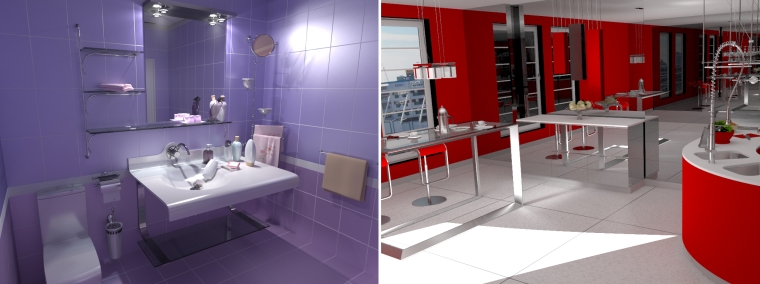 |
Jaroslav KÝivŠnek |
Path Integral Methods for Light Transport Simulation: Theory & Practice
Curated Tutorial at EUROGRAPHICS 2014
|
Jaroslav KÝivŠnek
Charles University in Prague |
Iliyan Georgiev
Saarland University |
Anton S. Kaplanyan
Karlsruhe Institute of Technology |
Juan Canada
Next Limit Technologies |
The advanced rendering methods, covered in this tutorial, can handle scenes with complex specular lighting. The left image was rendered with the vertex connection and merging algorithm [Georgiev et al. 2012]. The image on the right was rendered with Metropolis light transport. Manifold exploration [Jakob and Marschner 2012] mutation strategies were used, extended with path space regularization [Kaplanyan and Dachsbacher 2013] to capture reflected caustics from the external point light source.
Abstract
We are witnessing a renewed research interest in robust and efficient light transport simulation based on statistical methods. This research effort is propelled by the desire to accurately render general environments with complex materials and light sources, which is often difficult with the currently employed solutions. In addition, it has been recognized that advanced methods, which are able to render many effects in one pass without excessive tweaking, increase artistsí productivity and allow them to focus on their creative work. For this reason, the movie industry is shifting away from approximate rendering solutions toward physically-based rendering methods, which poses new challenges in terms of strict requirements on image quality and algorithm robustness.
Many of the recent advances in light transport simulation, such as the robust combination of bidirectional path tracing with photon mapping (Vertex Connection and Merging / Unified Path Space), or the new Markov chain Monte Carlo methods are made possible by interpreting light transport as an integral in the space of light paths. However, there is a great deal of confusion among practitioners and researchers alike regarding these path space methods.
The goal of this tutorial is twofold. First, we present a coherent review of the path integral formulation of light transport and its applications, including the most recent ones. We show that rendering algorithms that may seem complex at first sight, are in fact naturally derived from this general framework. A significant part of the tutorial is devoted to the application of Markov chain Monte Carlo methods for light transport simulation, such as Metropolis Light Transport and its variants. We include an extensive empirical comparison of these MCMC methods. The second part of the tutorial discusses practical aspects of applying advanced light transport simulation methods in practical architectural visualization and VFX tasks.
Publication & Presentation
Jaroslav KÝivŠnek, Iliyan Georgiev, Anton Kaplanyan, and Juna Canada. Path Integral Methods for Light Transport Simulation: Theory & Practice. In EUROGRAPHICS 2014 Tutorials ... BibTeX entry
Presented on Monday, 7 April, afternoon session (program).
Syllabus & Course Notes
Syllabus & course overview (PDF).
Up-to-date materials will be posted after the conference.
| 1:30pm ... | Introduction & Welcome (KÝivŠnek)  notes pages | notes pages |
 slides | slides |
 slides slides
|
| 1:40pm ... | Path Integral Formulation of Light Transport (KÝivŠnek)  notes pages | notes pages |
 slides | slides |
 slides slides
|
| 2:00pm ... | Bidirectional Path Sampling Techniques (KÝivŠnek)  notes pages | notes pages |
 slides | slides |
 slides slides
|
| 2:20pm ... | Vertex Connection and Merging (Georgiev)  notes pages notes pages
|
| 2:45pm ... | break |
| 2:50pm ... | Markov Chain and Sequential Monte Carlo Methods (Kaplanyan)  notes pages | notes pages |
 slides | slides |
 slides slides
|
| 3:15pm ... | Comparison of Advanced Light Transport Methods (Kaplanyan)  notes pages | notes pages |
 slides | slides |
 slides | slides |
|
| 3:40pm ... | Advanced Light Transport in the VFX/Archiviz Industry (Canada)  notes pages | notes pages |
 slides | slides |
 slides | slides |
|
Acknowledgements
This work was partially supported by the Czech Science Foundation grant P202-13-26189S.
